Why These Designers Are Combining Their Retail and Studio Locations
A look inside the industry trend of these dually functional fashion spaces.
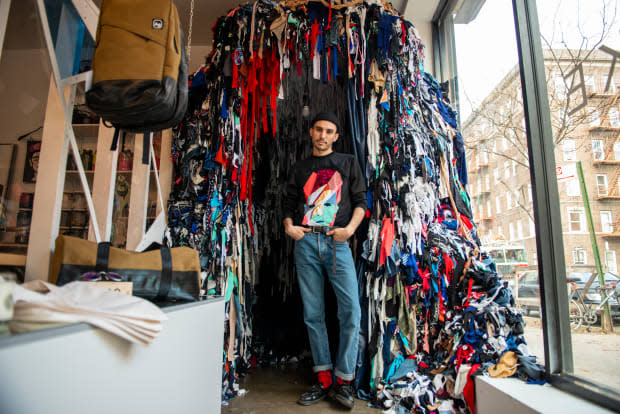
The call for transparency in fashion is ringing louder than ever before, and brands are taking several different approaches to answer it. Some are disclosing their supply chains, some are offering a behind-the-scenes look into production and cost breakdowns, and some brands are literally laying it all out on the table — the cutting table, that is. The rise of combining studio and retail locations has been a slow-but-steady industry trend, with 3x1 Denim's retail store/denim atelier hybrid in New York City's SoHo kicking things off in 2009 to Teressa Foglia's Industry City studio-meets-showroom, which opened in December 2017.
Similar to the popular concept of open kitchen restaurants in the culinary world, designers have decided to pull back the curtain on how they create their designs by giving their customers an inside look at the process. In the fashion industry, there isn't an official name for this type of space, but Daniel Silverstein's "make/shop" in Brooklyn's Williamsburg seems to sum it up pretty well: His label Zero Waste Daniel, as the name would suggest, is a brand that doesn’t generate any waste from its products, and the designer's focus across every step of the design process can happen all under one roof.
Related Articles
8 Fashion and Beauty Editors on How Their Jobs Impacted Their Careers
How Fashion Brands Can Create a More Sustainable End-to-End Retail Economy
Could Tiffany & Co. Tip the Scales in Favor of a More Transparent Diamond Industry?
"Co-locating my production and retail saves time, energy and allows me to maximize every day," says Silverstein. "I'm also able to keep a closer eye on production, customer service and little details that matter to me as a designer and a brand. I can both do my job as a designer but also interact with customers and show anyone who doubts zero waste and that my work is in fact made of scraps."
For Scott Morrison, founder of 3x1, the idea to combine the denim brand's retail location and atelier was sparked when he realized that most people don't understand how jeans are made. "I thought if we could figure out a way to showcase the process, it could be a really powerful experience for people," he says. As a result, sewing machines were positioned behind glass walls at the brand's SoHo flagship, creating what Morrison refers to as the "Disneyland of Denim."
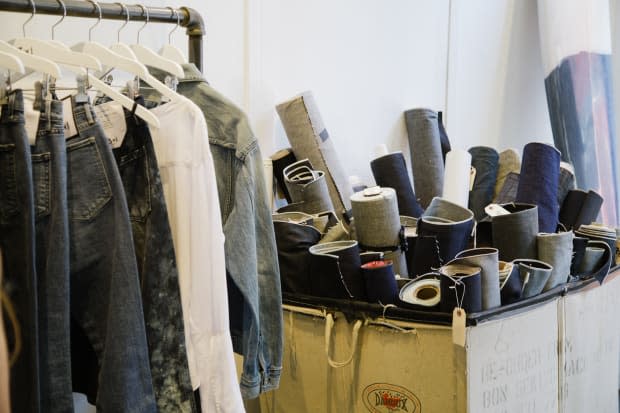
And while the merging of two spaces might seem like a money-saver on some level, he notes that they are still paying a premium price for the downtown location. "It’s not even that cost-effective, but our customers appreciate the magic of seeing the process right in front of them," says Morrison. "Being included in that experience gives you sense of value for a more luxury item." Today, 3x1's SoHo location produces about 2,000 pairs of denim each year — which vary from samples to custom offerings to bespoke or made-to-measure denim — while the rest of its regular wholesale collection is created at a separate manufacturer in Los Angeles.
Designer Ellie Mae Waters didn't intend to merge her Toronto, Canada-based studio and retail location on purpose, which houses the pieces for her namesake brand Ellie Mae Studios. (The only items from her brand that aren't made in-house are knits that are outsourced from Peru.) "When I first found the space, I originally wanted it to be the design studio, not the retail shop," recalls Waters. "But we just started running the business on both sides from there." This wasn't always the case: The brand first started out as a wholesale business, which demanded bigger numbers and a higher volume of product. But when Waters decided to make her company direct-to-consumer, she wondered why she would trust other people to make her pieces. "Our biggest hurdle working with manufacturers in Canada was that they always wanted us to commit to a huge size run," says Waters. "Ivy and Sandy, our seamstresses, have the patience and the time to make sure each piece is up to our standards."
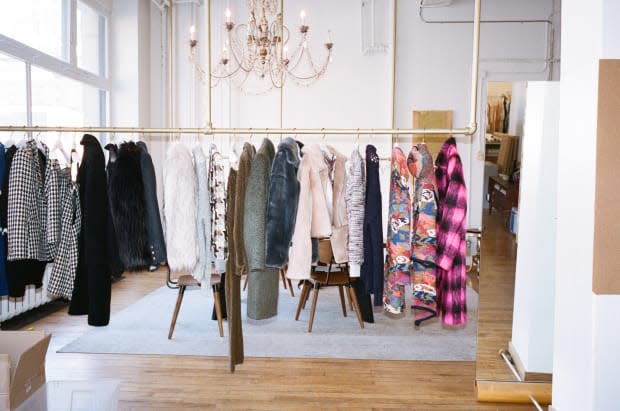
In addition to this combined space, Waters has brought Ellie Mae Studios to Stackt, a cultural marketplace in Toronto where brands can create a pop-up shop inside of old shipping containers. Waters notes that the foot traffic is heavier at that location since customers can wander through and shop a variety of brands all at once, but it may encourage those who stop by to visit her storefront as well.
While on a little "break from life" in the south of France, Teressa Foglia took a hat-making course, and her creations spurred requests from friends. After returning to New York and searching for studio spaces in Bushwick in Brooklyn and Tribeca in Manhattan, Foglia couldn't seem to find a place that was suitable. A friend told her about Industry City Studios, along the waterfront of Brooklyn's Sunset Park, and she finally settled on a place where she first started up-cycling vintage hats before making her very own. Custom hats are Foglia's bread and butter of the business, and she offers to invite clients down to her studio to be a part of the experience. "We become emotionally invested with our clients and whenever someone comes in the shop, I leave with a new friend," she says. "Sharing every aspect of the product experience has allowed us to build brand loyalty."
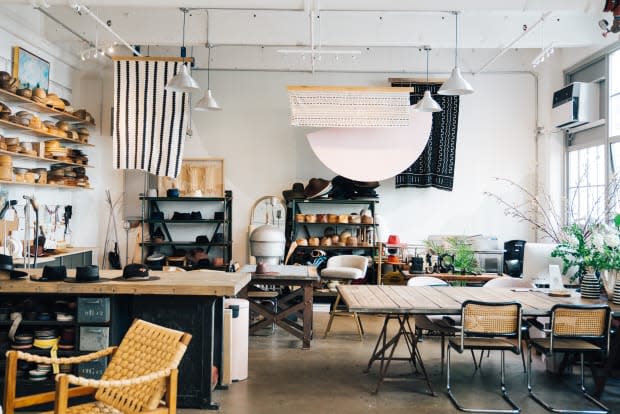
Merging the two spaces has also been advantageous for Foglia because she has complete creative control over each product and can respond immediately when there's a question or an issue. "We have a high price point because of that bespoke aspect. We do want to scale and be in big retailers, but we need to be able to do it our way. We're handmade over mass-made and it all goes back to who we are as a brand," says Foglia. On average, she and her team can create 10 to 20 hats a week, depending on the base material, but the actual production that takes place in the space can vary from day to day. "Sometimes it can take two full days just to make two hats, or sometimes we'll have an order of 35 to 50 hats and be blocking and trimming for three days straight to fulfill it," she says.
According to Morrison, what makes these dually functioning spaces so unique is that they serve as a point of differentiation between one's brand and any competitors: "People have a genuine curiosity to understand how things are made. Generally, if you want to tailor or alter a piece of clothing, you have to outsource it, so our ability to offer personalization in the store is a great way to stand out," he says.
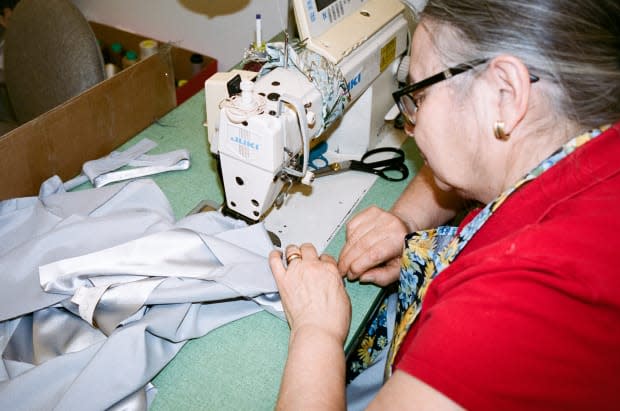
Another point which can't be ignored is the brands' commitment to sustainability. Silverstein's environmental awareness is literally built into the name of his company, but for other brands, there is a benefit to showing off the process of how a piece is made. "One thing that we very much promote is that our hats will last forever," says Foglia. "We don’t want you to go out and buy seven hats. Buy a hat from us and if you want to come back in a few months and redesign your hat we can reshape it, swap out trimmings and you could have a virtually new hat every few months."
As this trend of combined workspaces becomes more popular, Silverstein hopes that everyone will find a way to put their own individual spin on it. "Aspiring entrepreneurs should always look for gaps in the market and find their own unique voice," Silverstein says, adding that it can be hard for small brands to keep up with more mass-produced brands, especially if they come with clout or the backing from a celebrity. "The thing we rely on as trained designers and artists is our skills, craft and unique style," he says. "Highlighting this in our business is one of our biggest assets so why hide it?"
Sign up for our daily newsletter and get the latest industry news in your inbox every day.
